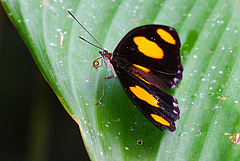Neuer Ansatz für globales Arten-Monitoring

Data to assess distributions and trends varies vastly among groups of organisms. Many tropical butterflies like the blue-frosted banner (Catonephele numilia) often only have a few records (picture: Walter Jetz).

Bird species in North America or Europe like the mallard (Anas platyrhynchos) on the other hand are mostly well documented with millions of records annually (picture: Walter Jetz).
New Haven, Leipzig. Eine Gruppe internationaler Experten unter Beteiligung des Deutschen Zentrums für Integrative Biodiversitätsforschung (iDiv) hat einen dringend notwendigen Ansatz entwickelt, um die Erfassung von Zustand und Veränderung von Arten weltweit deutlich zu verbessern. Das Ergebnis entstand in einer mehrjährigen Zusammenarbeit unter der Schirmherrschaft des Group on Earth Observations Biodiversity Observation Network (GEO BON). Der Bericht wurde nun in Nature Ecology & Evolution veröffentlicht.
Die vollständige Meldung gibt es nur auf Englisch.
